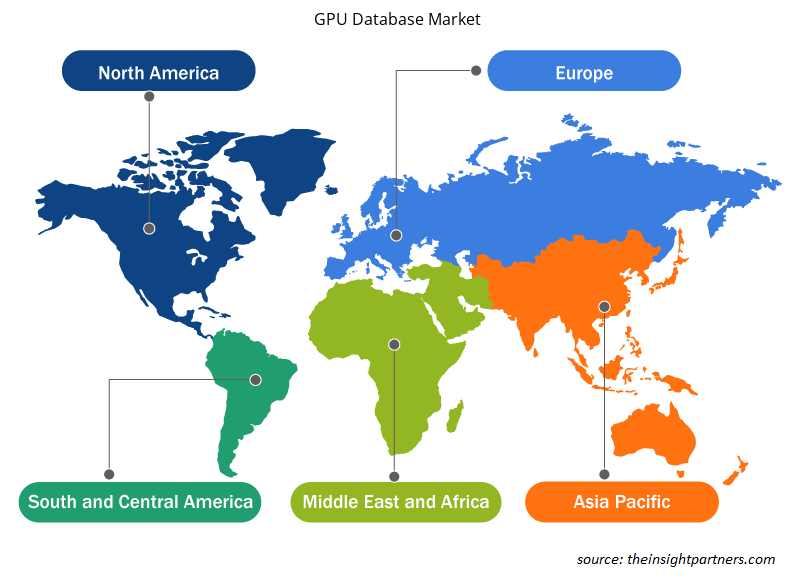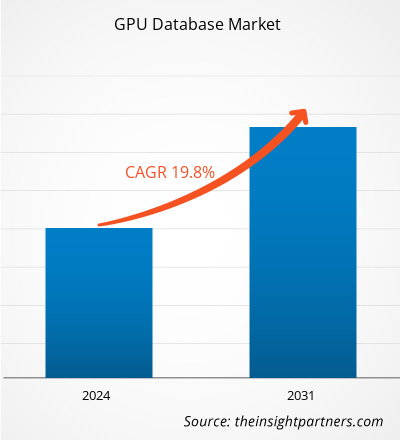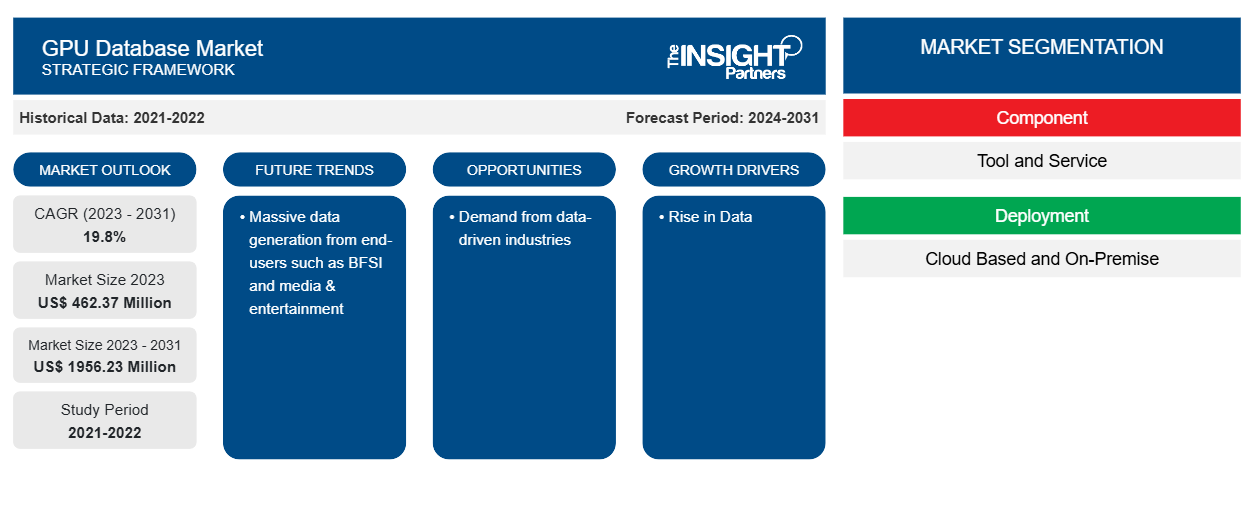GPU 数据库市场规模预计将从 2023 年的 4.6237 亿美元增至 2031 年的 19.5623 亿美元。预计 2023-2031 年期间市场复合年增长率将达到 19.8%。数据的增长和数据驱动型行业的增长可能仍是市场的主要趋势。
GPU数据库市场分析
不断增长的数据驱动型行业是 GPU 数据库市场的主要驱动因素之一。数字化的兴起和公司对处理大型数据集的解决方案的倾向正在推动市场增长。GPU 数据库应用于一些新兴技术,如人工智能、机器和深度学习、物联网 (IoT) 和地理空间分析,这为 GPU 数据库市场增长创造了巨大的机会。
GPU 数据库市场概览
GPU 数据库使用图形处理单元 (GPU) 来执行数据库操作。GPU 是一种可编程处理器,旨在快速渲染高分辨率图像和视频。GPU 数据库比 CPU 更快、更有效地处理大量数据,因为它们并行运行而不是按顺序运行。因此,GPU 数据库通常更快且更适合分析,在处理多种不同类型的数据或大量数据方面更灵活。
定制此报告以满足您的需求
您可以免费定制任何报告,包括本报告的部分内容、国家级分析、Excel 数据包,以及为初创企业和大学提供优惠和折扣
- 获取此报告的关键市场趋势。这个免费样品将包括数据分析,从市场趋势到估计和预测。
GPU 数据库市场驱动因素和机遇
数据上涨利好市场
随着数字化的到来,数据以惊人的速度生成。需要分析和处理各种类型、数量和速度的数据,以便在数据分析技术的帮助下发现任何隐藏的模式和见解。传统分析无法提供最佳的分析技术。这就产生了对 GPU 数据库的需求。凭借大规模并行处理能力,GPU 数据库可以经济高效地提供高性能计算。GPU 数据库是处理大型数据集的理想解决方案,这推动了对这项技术的需求。
来自数据驱动行业的需求。
GPU 数据具有很高的计算能力。由于它们的并行处理能力,它们处理数据的速度比仅包含 CPU 的配置快 100 倍,如图所示。因此,各种数据驱动的行业(例如 BFSI、媒体和娱乐等)都需要针对数据分析应用程序的处理密集型工作负载的解决方案,这推动了对 GPU 数据库的需求。市场参与者正在推出解决方案来满足这一需求。Graphistry 推出了 Hub Pro(Graphistry Hub for Professionals),为客户带来 GPU 加速的可视化图形分析。Graphistry Hub Pro 解决了个人的安全、定价和维护问题,以及即将推出的 Hub Organizations 解决了团队的问题。(来源:Graphistry,新闻稿,2021 年 9 月)
GPU 数据库市场报告细分分析
有助于得出 GPU 数据库市场分析的关键部分是组件、部署、应用程序和垂直行业。
- 根据组件,GPU 数据库市场分为工具和服务。工具部分在 2023 年占据了最大的市场份额。
- 根据部署方式,市场分为基于云和本地部署。基于云的部署预计将以最高的复合年增长率增长。
- 根据应用,市场细分为欺诈检测和预防、治理风险与合规 (GRC)、客户体验管理、预测性维护、供应链管理、威胁情报等。客户体验管理在 2023 年占据了相当大的市场份额。
- 按行业垂直划分,市场分为 BFSI、IT 和电信、零售和电子商务、医疗保健、运输和物流、政府和国防等。BFSI 在 2023 年占据了相当大的市场份额。
GPU 数据库市场份额(按地区)分析
GPU数据库市场报告的地理范围主要分为五个区域:北美、亚太、欧洲、中东和非洲、南美和中美。
预计亚太地区将以最高的复合年增长率增长。印度和中国等发展中经济体的数字化发展和对高级数据分析技术的需求不断增长,推动了该地区市场的增长。BFSI、医疗保健、制造业等数据驱动行业的数字化转型进一步推动了市场增长。从大数据集中提取见解的需求不断增长,推动了亚太地区的市场增长。
GPU 数据库市场区域洞察
Insight Partners 的分析师已详细解释了预测期内影响 GPU 数据库市场的区域趋势和因素。本节还讨论了北美、欧洲、亚太地区、中东和非洲以及南美和中美洲的 GPU 数据库市场细分和地理位置。

- 获取 GPU 数据库市场的区域特定数据
GPU 数据库市场报告范围
| 报告属性 | 细节 |
|---|---|
| 2023 年的市场规模 | 4.6237亿美元 |
| 2031 年市场规模 | 19.5623亿美元 |
| 全球复合年增长率(2023 - 2031) | 19.8% |
| 史料 | 2021-2022 |
| 预测期 | 2024-2031 |
| 涵盖的领域 | 按组件
|
| 覆盖地区和国家 | 北美
|
| 市场领导者和主要公司简介 |
|
GPU 数据库市场参与者密度:了解其对业务动态的影响
GPU 数据库市场正在快速增长,这得益于终端用户需求的不断增长,而这些需求又源于消费者偏好的不断变化、技术进步以及对产品优势的认识不断提高等因素。随着需求的增加,企业正在扩大其产品范围,进行创新以满足消费者的需求,并利用新兴趋势,从而进一步推动市场增长。
市场参与者密度是指在特定市场或行业内运营的企业或公司的分布情况。它表明在给定市场空间中,相对于其规模或总市场价值,有多少竞争对手(市场参与者)存在。
在 GPU 数据库市场运营的主要公司有:
- 布莱特利特
- 版画艺术
- H2O.ai
- 杰多克斯
- Kinetica DB Inc.
- Neo4J 公司
免责声明:上面列出的公司没有按照任何特定顺序排列。

- 获取 GPU 数据库市场顶级关键参与者概览
GPU 数据库市场新闻和最新发展
GPU 数据库市场通过收集一手和二手研究后的定性和定量数据进行评估,其中包括重要的公司出版物、协会数据和数据库。下面列出了 GPU 数据库市场的一些发展情况:
- NVIDIA 和 HP Inc. 宣布将 NVIDIA CUDA-X 数据处理库与 HP AI 工作站解决方案集成,以增强数据准备和处理工作,这是生成式 AI 开发的基础。CUDA-X 库基于 NVIDIA CUDA 计算平台构建,可加快多种数据类型的数据处理速度,包括表格、文本、图像和视频。其中包括 NVIDIA RAPIDS cuDF 库,该库使用 NVIDIA RTX 6000 Ada Generation GPU 而不是仅使用 CPU 的系统,将使用 pandas 软件的近 1000 万数据科学家的工作速度提高了 110 倍,而无需进行任何代码更改。(来源:NVIDIA,新闻稿,2024 年 3 月)
- 矢量数据库技术的先驱者 Zilliz宣布发布 Milvus 2.4,该版本通过突破性的 GPU 索引功能为矢量搜索功能树立了新标准,该功能由 NVIDIA 的 CUDA 加速矢量检索图形索引 (CAGRA) 提供支持,CAGRA 是 RAPIDS cuVS 库的一部分。(来源:Zilliz,新闻稿,2024 年 3 月)
GPU 数据库市场报告覆盖范围和交付成果
“GPU 数据库市场规模和预测(2021-2031)”报告对以下领域进行了详细的市场分析:
- 范围内涵盖的所有关键细分市场的全球、区域和国家层面的 GPU 数据库市场规模和预测
- GPU 数据库市场趋势以及市场动态,如驱动因素、限制因素和关键机遇
- 详细的 PEST/波特五力分析和 SWOT 分析
- GPU 数据库市场分析涵盖关键市场趋势、全球和区域框架、主要参与者、法规和最新市场发展
- 行业格局和竞争分析,涵盖市场集中度、热图分析、知名参与者以及 GPU 数据库市场的最新发展
- 详细的公司简介
- 历史分析(2 年)、基准年、预测(7 年)及复合年增长率
- PEST和SWOT分析
- 市场规模、价值/数量 - 全球、区域、国家
- 行业和竞争格局
- Excel 数据集
近期报告
客户评价
购买理由
- 明智的决策
- 了解市场动态
- 竞争分析
- 客户洞察
- 市场预测
- 风险规避
- 战略规划
- 投资论证
- 识别新兴市场
- 优化营销策略
- 提升运营效率
- 顺应监管趋势





















 获取免费样品 - GPU数据库市场
获取免费样品 - GPU数据库市场